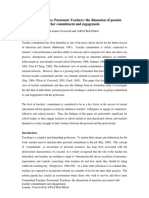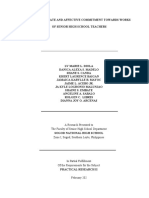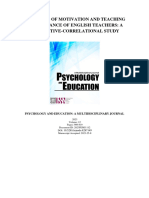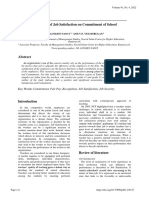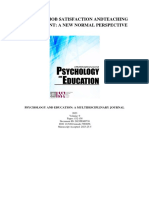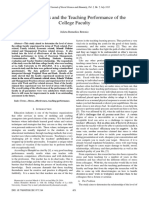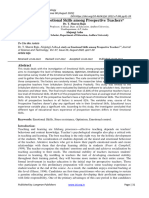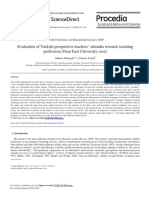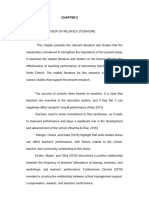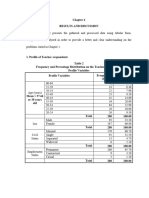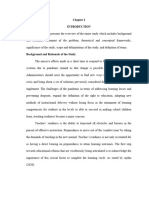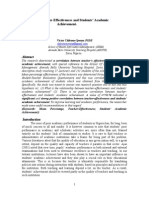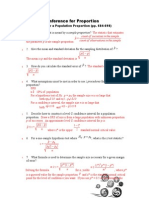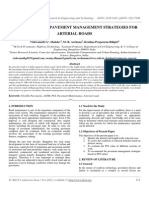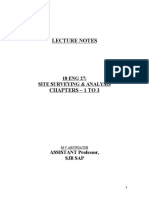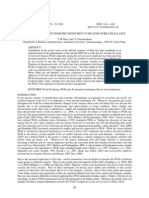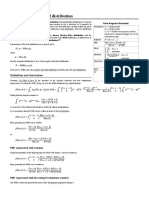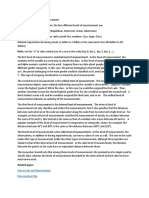Graduate School
MARJORIE C. ORTEGA
ADVANCE RESEARCH AND METHODOLOGY
Please read at least 5 published research related to your approved topic using the matrix below:
Author, Title, Year Research Objectives Sample, Locale and Methods Major Findings
Published
Elmer G. Doronila IV, This study aimed to The respondents of the study were 165 permanent The findings of the study were the
Teachers’ Morale and determine the teachers from 17 public school elementary schools following:
Pupils’ Academic significance of the randomly selected in southern part of the Division of 1. The teachers in public elementary
Achievement in relationship between Antique under the administration and supervision of schools in southern part of Division of
Elementary Schools, the teachers’ morale the Schools Division Superintendent. Sample Size and Antique have “high” level of morale in
2013 and pupils’ academic Sampling Technique. The sample size of teachers and terms of rapport with the principal,
achievement. pupils in this study were determined using the Gay’s satisfaction with teaching, rapport
formula. To ensure that all parts of the population are among teachers, teacher salary, teacher
represented in the sample, a stratified random sampling load, curricular issues, teacher status (in
was implied in this study. The public elementary the community), community support for
schools were group according to districts, from each education, and community pressures
district 10% of the total schools were selected using (expectations).
simple random (fishbowl) sampling technique. A 2. The teachers in public elementary
descriptive-correlational research design was schools in southern part of Division of
employed in this study. According to Calmorin (2003), Antique have “low” level of morale in
descriptive research describes the nature of the terms school facilities and services.
situation as it exists at the time of the study and to 3. The academic achievement of pupils
� explore the causes of a particular phenomenon. in public elementary schools in southern
Correlational research, on the other hand, involves part of the Division of Antique in terms
collecting data in order to determine whether, and to of the National Achievement Test
what degree, a relationship exist between two or more overall rating was “moving towards
quantifiable variables (Basillo, 2003). Accordingly, mastery”.
this study used the correlational approach to determine 4. Positive and significant relationship
the relationship between teachers’ morale and pupils’ was found between teachers’ morale in
achievement in public elementary schools in the terms of rapport with the principal,
Division of Antique. This study utilized a published- satisfaction with teaching, rapport
standardized instrument for data collection, the Perdue among teachers, teacher salary, teacher
Teacher Opinionaire validated by experts in the field load, curricular issues, teacher status (in
of education. The Purdue Teacher Opinionaire (PTO). the community), community support for
To ascertain the level of teacher’s morale among education, school facilities and services,
public school teachers, the Purdue Teacher Opinionaire and community pressures (expectations).
(PTO) Rempel& Bentley (1980) was used. 5. Positive and significant relationship
between teachers’ morale and pupils’
academic achievement.
Adolphina Mwesiga The main purpose of The study employed the convergent parallel design, the The study indicated a high level of
and EVANS OGOTI the study was to quantitative and qualitative strands were conducted teachers’ commitment in terms of
OKENDO, Levels of investigate the extent to concurrently but independently. The quantitative observing to teaching professional
Teachers Commitment which strand was used to collect data from teachers, on responsibilities. Moreover, the study
to the Teaching teachers in secondary practices of established that teachers’ teaching
Profession in schools are committed teaching and the actual levels on their commitment as commitment were limited by several
Secondary Schools in to their teaching per teaching profession. Qualitative on the other hand challenges such as; poor training and
Kagera Region, profession. was frequency of seminars, workshops and
Tanzania,2018 employed to understand the reality of head of schools, professional development, ineffective
on their experiences, and leadership practices in involvement in school decision making,
improving teachers’ commitment. ineffective communication, lack/poor
A sample of 352 participants was drawn from a total training, incompetent head of schools,
number of 3961, which is approximately ten percent of low salaries, lack of motivations,
the entire population. A study sample comprised 32 lack of security and compensation, poor
head working environment and government
of schools, 32 academic masters and 288 teachers, with interference in the teaching
a total of 352 participants. Both probability and non- profession. The study recommended that
probability sampling procedures were used to select the Government, heads of schools and
� participants of the study. The study utilized the community should handle
questionnaires, interview guide, and document analysis issues of school headship and teacher’s
guide for data collection. commitment effectively.
Irena Burić & Ivana To examine and The study included a sample of 941 teachers from Teachers who reported higher levels of
Macuka, Self-Efficacy, explore the role of self- various state schools in Croatia. A cross-lagged positive emotions of joy, pride and love
Emotions and Work efficacy with respect to analysis demonstrated the reciprocal nature of the at first time point, tended to be more
Engagement Among teachers’ emotions and relationship between emotions and work engagement. engaged in their work at subsequent
Teachers: A Two Wave work engagement. assessment. The association between
Cross-Lagged negative emotions and work engagement
Analysis,2017 showed the opposite direction—teachers
who experienced more anger, fatigue,
and hopelessness in the first
measurement point, were also less
engaged at second time of assessment.
Furthermore, teachers who were more
engaged in their work in the first time
point, also reported about lower levels
of negative emotions but higher levels of
positive emotions 6 months later. At
last, teachers with higher perceived self-
efficacy are more engaged in their work,
experience more joy, pride and love, and
less anger, fatigue and hopelessness,
towards their students.
Betta Fitriasar and The purpose of this Participants in this study were 82 teachers selected by The results of this research showed that
Rohmatul Ummah, study was to determine purposive sampling technique, which is used according significant self-efficacy affects work
Self-Efficacy in Terms how the effect of self- to the required sample requirements. This research engagement, and affective commitment
of Work Engagement efficacy on work subject is all of the teachers at Madrasah Tsanawiyah mediates work engagement and self-
and Affective engagement that was Negeri Bojonegoro. This study uses quantitative efficacy. This finding is supported by
Commitment Among mediated by affective research that is based on the relationship between the opinion of Kuntjoro (2002) who
Teachers,2020 commitment variables and is associated with existing theories. This states that organizational commitment is
research design uses correlational studies that discuss important to the organization to make
the relationship between two or more variables commitment as an important
(Sugiyono, 2010). This study was conducted to prerequisite for carrying out the position
determine the influence between self-efficacy of Work of a job that they occupy.
� Engagement mediated by Organizational
Commitments (Affective Organizations). Data
collection uses a questionnaire, which is a way of
collecting data by giving a list of questions or
statements to be answered by respondents
(Sugiyono,2016). In this study, the measurement scale
of research variables uses a Likert type scale and is
carried out at the same time to compare differences in
results between research subjects or individuals
Fibie Liona This research aims to The population for this study is all school teachers The research findings demonstrated that
Pangaribuan, Leo identify the impact of Public Junior High School, Kerajaan District, Pakpak there is relationship between self-
Sartika Pasaribu, and self-efficacy and work Bharat 64teachers. The sample in this study was 55 efficacy and teacher work discipline.
Agus Letwing Manik, commitment towards teachers using the formula Slovin with level of The effect of self-efficacy
The Effect of Self- teachers work significance (margin of error) is set at 5% or 0.05. This and work commitment towards teachers’
Efficacy and Work discipline among public study uses a quantitative design approach using work discipline is16.5%, The
Commitment school teachers in descriptive research to explain the characteristics of implications of the research are: 1) Self
ofTeachers at Kerajaan District, each of the variables studied. The research instrument efficacy can be improved by giving
School,2020 Pakpak Bharat. is by using a questionnaire. The data collection motivation and reward to the teacher,
technique used was the questionnaire distributed to and 2) Work commitment can be
teachers throughout the Public Junior High School, improved by enhancing a good
Kerajaan District, Pakpak Bharat, with this method of communication and team work among
data collected on respondents' answers on the list of the teachers.
questions (questionnaire).The questionnaire was
prepared using a Likert scale with each question are
given alternative answers to as many as five choices of
the answer options: 1 to disagree, 2 for less agree, 3for
quite agree, 4 to disagree and 5 for strongly agree
